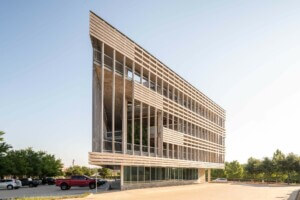When Professor Michael Garrison, the Cass Gilbert Centennial Teaching Fellow in Architecture at the University of Texas at Austin, thinks about how students are pushing the cutting edge in design, three developments come to mind. First, said Garrison, who will participate in the “Form Follows Performance” panel at the upcoming Facades+Dallas conference, is a heightened attention to materiality. “Our students are keen on new materials, the embodied energy of materials, smart materials,” he explained. This new awareness is largely the result of students’ exposure to the school’s University Co-op Materials Lab, a multidisciplinary space for hands-on exposure to more than 27,000 materials samples.
Second is the question of craft. “We find it very interesting that naval architects and NASA call their works craft, but we in architecture don’t know such things,” said Garrison, recalling Buckminster Fuller’s question, “How much does your house weigh?” Thanks to developments in digital design and fabrication, he said, “the old idea of tool and die mass production characteristic of modern thinking in the twentieth century has really changed. Students are able to make something of a more unusual shape.” Parametric design is the new normal in the design-school classroom.
Finally, Garrison points to a “new and profound” evolution away from “the hermetically sealed box of the Seagram Building era” to a focus on “thick skins.” These multi-layered facades typically involve a sunshade or other external component, which “creates an interstitial space between the traditional envelope and the new envelope,” said Garrison. Increasingly, students are focused on incorporating adaptive technology into building envelopes, often patterning facades along biomimetic lines. “Whereas the first two decades of the twenty-first century were about unusual shapes, [with] parametric design, we are now moving toward intelligent shapes that are more responsive,” he concluded.
Catch up with Garrison and other top AEC industry professionals at Facades+Dallas. Seating is limited; register today.










